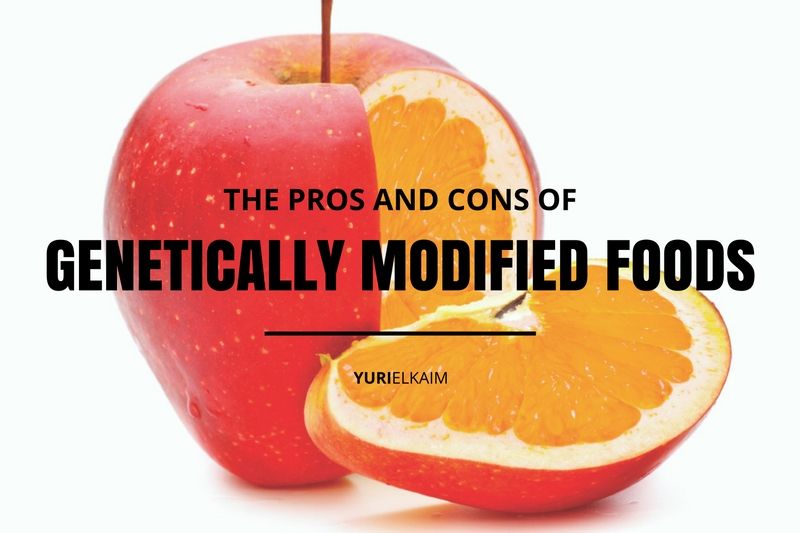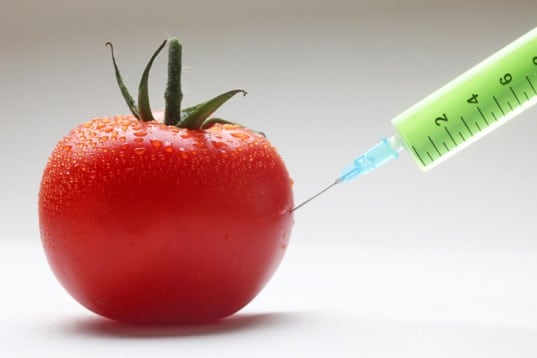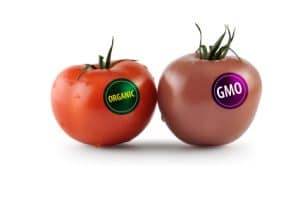In this article
Unless you’ve been living under a rock, chances are you’ve heard about genetically modified organisms – or foods – and the constant controversy that seems to surround them.
Shrouded in mystery, most of us still scratch our heads when we hear terms like “Monsanto” or “biotechnology.”
Whichever side of the fence you find yourself on (I’m on the against) when it comes to genetically modified foods, it’s clear that they probably won’t be going anywhere anytime soon.
As a consumer and health-conscious individual, it’s vital that you understand what GMOs are, the pros and cons of genetically modified foods, the implications on your health, and the sources in the food supply.
What are Genetically Modified Foods?
Genetically modified organisms (GMOs) are plants, animals, or organisms whose DNA has been artificially manipulated to modify their characteristics.
Through genetic engineering, scientists can handpick and extract specific genes from organisms, bacteria, and viruses and inject them into other organisms.
This process creates new species with an “improved” set of traits and a genetic code not found in nature.
GMOs are all around us. Many clothes, paper products, laundry detergents, and even cosmetics on the market today rely on genetically modified agricultural products.
GMOs are also abundant in the food supply. Crops are often modified to lower production costs and increase resistance to disease.
But at what cost?
Though the government classifies genetically modified foods as “safe,” there’s still a great deal of disagreement about just how safe GMOs really are.
Let’s take a look at what you need to know about these controversial crops and the implications on our health.
Benefits of GMOs
There are certainly some pros of genetically modified foods and the use of genetic engineering.
Here are a few:
They save us money.
Genetically modified crops don’t require as much water, land, or pesticides as traditional crops, which translates to savings for both farmers and consumers.
Without the use of biotechnology, prices for staples like corn, soybeans, and canola would be up to 10 percent higher (1).
They shrink our ecological footprint.
The decreased dependence on pesticides and greater utilization of resources has led to some serious environmental benefits.
Since the initial adoption of GMOs in 1996, pesticide use has decreased by about 19 percent.
It has also led to a reduction in greenhouse gases, roughly the equivalent of taking 12 million cars off the roads (2).
They increase food production.
GMOs make it possible to increase crop yields and extend farming into marginal land and inhospitable conditions.
Thanks to genetic engineering, plants can now thrive through droughts and in depleted soil.
They could help prevent world hunger.
Over a billion people are affected by global hunger, and the number grows daily.
It is estimated that by 2050, food production will have to increase by 70 percent to be able to meet the rising demand (3).
Many have theorized that the increased production and efficiency provided by GMOs could be integral in ending world hunger and providing food security worldwide.
They could be used to improve nutritional value.
Yes, GMOs have even been explored as a method to enhance the nutrients found in our food.
Golden rice, for example, was created through genetic engineering as a vitamin-rich alternative to white rice.
It was specifically proposed as a solution to vitamin A deficiency, which leads to blindness, vision problems, and even death for over a million children each year.
Golden rice was produced to boost the intake of beta-carotene, the precursor to vitamin A, in areas commonly afflicted with vitamin A deficiency.
While critics have pointed out that it might be unrealistic to meet vitamin A needs through golden rice alone (you would need to eat a lot), it could be a step in the right direction when it comes to how we should be using biotechnology.
Negatives of GMOs
Despite the benefits of GMOs, there are definitely some cons of genetically modified foods as well. Here are a few of the not-so-great things that come as a result of tampering with our food:
They could cause allergies.
One of the most common concerns when it comes to genetically modified foods is their possible allergenicity.
With the movement of genetic material from one organism to another comes the dangerous potential of transferring allergens as well.
Studies have even shown that genetic modification could cause the formation of new allergenic proteins (4).
This means that you could be allergic to the GM-version of a food, even if you have no problem with the non-GMO version.
There are environmental risks.
The prospect of GMOs intermingling with non-GMOs and introducing engineered genes into the environment is a frightening possibility that seems like it could be straight out of a sci-fi movie.
There are also dangers when it comes to loss of biodiversity and the impact on populations of other species due to environmental changes.
The decline of Monarch butterflies, for example, is blamed on exposure to toxic pollen from genetically modified corn.
There could be other negative health effects.
There have been several studies linking genetically modified foods to undesirable consequences on health.
Many GMOs contain genes that make them resistant to antibiotics. Introducing these foods into the food supply means a dramatic decrease in the effectiveness of antibiotics.
While I don’t personally recommend the use of antibiotics, much of the population still depends on them to treat infection and disease.
Antibiotic resistance caused by GMOs could quickly spiral into an enormous threat to public health.
Multiple animal studies have also raised concerns about the role that GMOs could play in the disruption of the digestive system (5, 6) while other studies have even found toxins present in GMOs circulating through the bloodstream (7)!
It’s hard to determine the full extent of damage that GMOs could have on the body, however, because:
The research is lacking.
Long-term human studies on the impact of GMOs are needed. Most available research looks solely at animals, which is not exactly applicable to the general (human) population.
In the GMO debate, everyone seems to have a strong opinion swayed in one direction or the other. It can be hard to find non-biased sources that present the facts without putting a personal spin on it.
A substantial amount of the studies aimed at genetically modified foods have also been funded by GMO companies, like Monsanto. Not exactly reliable.
Pending the publication of more thorough and objective studies, it can be difficult to definitively determine if the benefits of GMOs outweigh the risks.
There’s very little transparency in the industry.
You would think there would be some kind of rules or regulations when it comes to GMOs in the food supply.
You would be wrong.
That’s right, companies are not even required to list GMO ingredients on their labels.
Food industry titans have fiercely opposed any form of regulation that would require GMO labeling because they believe that consumers would perceive products containing GMOs as unsafe or dangerous.
Though this would be good for consumers who want to take control of their health, it would be bad for the wallets of the food industry.
Even now, companies are finding sneaky new ways to work around mandatory labeling laws.
In fact, a bill recently passed allowing companies to reveal GMO ingredients through a QR code on the packaging rather than directly on the ingredient label!
Without being able to rely on the food industry to keep us informed, it’s our responsibility as consumers to take action and make informed decisions about our health.
Top 6 GMO Foods
Though the jury is still out when it comes to the safety of genetically engineered foods, you should always be aware of what you’re putting into your body.
If you’re concerned about some of the nasty side effects associated with GMOs, we’ve put together a genetically modified food list to make it simple.
Here are the top six sources of GMOs as well as some nutrition tips for how you can replace them in your diet:
1. Corn
Corn is commonly modified to resist pests and herbicides.
Genetically modified corn is found in a variety of products, like cereal, animal feed, alcohol, and corn syrup. Always look for corn labeled as organic to make sure you’re getting the real stuff.
Avoid the corn found in animal feed by opting for grass-fed beef and stick to healthier non-GM olive oil instead of corn oil.
2. Soybeans
Soybeans are plentiful in the food supply, producing tofu, edamame, and soy milk.
Unfortunately, the vast majority of soybeans have been engineered to resist herbicides.
Swap your tofu for organic chicken, nuts, and almonds and trade the soy milk for almond or rice milk.
3. Sugar
Bad news for those with a sweet tooth: the sugar that’s often listed on the ingredient label is often referring to beet sugar, a crop commonly modified with pest-resistant genes.
The good news is that stevia, maple syrup, and raw honey are all great non-GM alternatives to add a touch of sweetness to your foods.
4. Fruits and Veggies
Unfortunately, not even produce is completely safe from the reach of genetic engineering.
Zucchini, squash, potatoes, tomatoes, and papayas are all commonly grown from genetically modified seeds.
The simple solution is to select the organic version of these fruits and vegetables and dodge the GMO bullet.
5. Vegetable Oil
Crops that are typically grown and used in vegetable oils (cottonseed, canola, and rapeseed) have more often than not been altered to resist herbicides.
Drop the vegetable oil and switch to coconut oil, butter, or olive oil instead to enjoy your food sans-GMO.
6. Dairy
Milk at the grocery store often comes from cows who have most likely been injected with hormones and fed genetically-modified corn feed.
Ditch the dairy altogether and opt for non-dairy choices like almond milk, rice milk, or coconut milk.
Summing It Up
What we put in our body has immense effects on every aspect of our health.
It is clear that a bigger conversation about food policy needs to happen in order to make lasting changes when it comes to including genetically modified foods in the food supply.
Still, one of the most important takeaway nutrition tips from the GMO debate is that we can (and should) be aware of where our food comes from – and exercise caution about what we choose to eat.
Do You Know Your Health Score?
Take this simple quiz and learn how you’re doing. Do you have any of these 20 signs that your body is silently sick and storing fat?
Click the banner below to start the quiz now!








